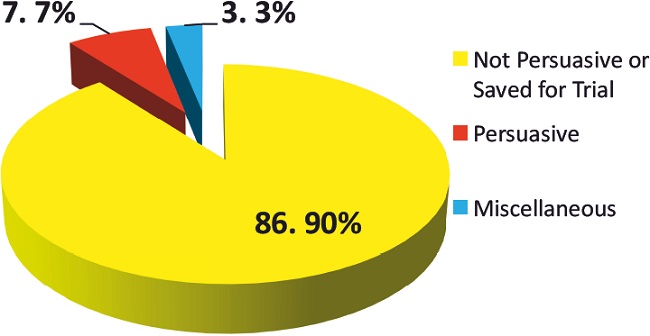Patent owners in the life sciences and chemistry areas must frequently decide whether to submit evidence of unexpected results as part of their preliminary responses in inter partes review (IPR) or other post-grant proceedings before the Patent Trial and Appeal Board (PTAB) at the U.S. Patent and Trademark Office. In some instances, the evidence of unexpected results may already be of record in the challenged patent's prosecution history, and the patent may even have been granted based on such evidence. In others, patent owners may have generated new data establishing that the claimed invention exhibits unexpectedly superior properties or results. In addition to considering the persuasiveness of the data, patent owners must strategically consider whether unexpected results evidence and arguments will be persuasive to the PTAB at the preliminary stage of a trial and lead to non-institution.
To assist patent owners with this important strategic decision, we have reviewed over 90 institution decisions issued by the PTAB that addressed a patent owner's submission of evidence and arguments related to unexpected results. Below we provide statistics on the PTAB's response to this evidence, summarize key decisions in which the PTAB responded favorably or unfavorably to such evidence, and identify factors for a patent owner to consider in its analysis of this key strategic question.
As of Sept. 8, 2017, we identified 184 PTAB institution decisions that referred to unexpected results. In 97 of these decisions, the board addressed the patent owner's submission of unexpected results evidence. In the remaining 87 decisions, the patent owner did not submit any evidence of unexpected results, but the board nonetheless mentioned the issue of unexpected results in its decision. A breakdown of the 97 cases in which unexpected results was addressed by the board is as follows:

As depicted, the board found unexpected results evidence persuasive in only 7.7 percent of these cases, and found the evidence to be either unpersuasive or preserved the issue for trial in the remaining 86.9 percent of cases.
Cases Where the Board Found Evidence of Unexpected Results Persuasive at the Preliminary Stage of an IPR
Evidence of unexpected results favorably influenced the board's decision not to institute trial in just seven of the 97 cases examined. In most of these instances, the board recognized that "substantially the same" arguments had been previously fully considered, analyzed, and accepted by the PTO and therefore exercised its discretion to decline institution. For example, in Lower Drug Prices for Consumers, LLC v. Forest Laboratories Holdings Ltd., IPR2016-00379, Paper 14 (P.T.A.B. July 1, 2016), the PTAB denied institution, finding that the petitioner's obviousness challenges were based on the same prior art reference and arguments that were addressed during prosecution of the patent. Id. at 9. There, the board itself had previously found that the patent owner established unexpected results in an ex parte appeal during prosecution, and that the petitioner's arguments against the evidence were the same as raised by the examiner. Id. The board even noted that the petition failed to address any of the asserted deficiencies found by the earlier panel and thus concluded that it was "not inclined to reconsider the Board's prior decision." Id. at 12.
The board has similarly denied institution when the prosecution history contained evidence of unexpected results and the examiner relied, at least in part, on such evidence in granting the patent. Coalition for Affordable Drugs V LLC v. Hoffman-LaRoche Inc., IPR2015-01792, Paper 14, p. 18 (P.T.A.B. Mar. 11, 2016). The board has even considered evidence of secondary considerations from a parallel proceeding before the U.S. International Trade Commission (ITC) as persuasive. Robert Bosch Tool Corp. v. SD3, LLC, IPR2016-01753, Paper 15, pp. 27–39 (Mar. 22, 2017). In this case, the patent owner relied upon evidence that was introduced during the ITC investigation against the petitioner, in which the administrative law judge concluded that the evidence of secondary considerations was "very strong" in favor of the patent owner. Id. at 28. Although the board found secondary factors other than unexpected results more persuasive, it relied on all of these secondary considerations in its decision to deny institution. Id. at 33.
Commonly, the PTAB will cite its discretionary power, under 35 U.S.C. §325(d), as an additional reason for declining to institute trial. See Adva Optical Networking, Inc. v. Rad Data Commc'ns Ltd., IPR2016-01848, Paper 6, pp. 20–21, 24 (Mar. 9, 2017); Robert Bosch Tool Corp. v. SD3, LLC, IPR2016-01754, Paper 15, pp. 19–20 (Mar. 22, 2017). Section 325(d) provides that, "[i]n determining whether to institute or order a proceeding ... the Director may take into account whether, and reject the petition or request because, the same or substantially the same prior art or arguments previously were presented to the Office." In considering the petitioner's arguments, the board will examine whether the petition sets forth new arguments, persuasive facts, or data to justify reexamining a previous finding by the PTO supporting unexpected results. Merely introducing an expert declaration containing the same arguments from the prosecution history may not be found sufficient to disturb a finding of unexpected results. Adva Optical, IPR2016-01848, Paper 6 at 20. If the petition fails to set forth any new evidence or arguments beyond what was in the prosecution history, the board may decline to "reweigh the evidence" and not institute trial. Id. The board has also found that it is petitioner's burden to address evidence of unexpected results known to the petitioner either from earlier prosecution, litigation, or the specification, and has denied institution when petitioner has failed to do so. See e.g., Praxair Distrib., Inc. v. INO Therapeutics, Inc., IPR2015-00522, Paper 12 at 16–17 (P.T.A.B. July 29, 2015).
To successfully persuade the board that evidence of unexpected results establishes nonobviousness, the evidence should be directly commensurate in scope with the claims at issue. The PTAB's decision in Lupin Ltd. v. Vertex Pharmaceuticals Inc., IPR 2015-00405, Paper 13 (P.T.A.B. July 9, 2015), exemplifies this requirement. There, the patent owner presented evidence that its patented compound, fosamprenavir, possessed unexpected results in the form of improved pharmacokinetics, lower side effects, and improved resistance profile than its parent drug. Id. at 18–19. Recognizing that one claim of the challenged patent was directed to compounds other than fosamprenavir, the board concluded that the unexpected results evidence was not commensurate in scope with that claim, and instituted trial regarding only that claim. Id. at 22–23. The board did not, however, institute trial on the claims that were directed only to fosamprenavir or its salts. Id.
As our analysis reveals, the PTAB rarely declines to institute trial on the basis of unexpected results evidence. In the few instances that it has done so, institution was denied because the petitioner proffered nearly identical arguments and prior art that the board had previously found unpersuasive. As demonstrated by Lupin, the board will interpret the arguments supporting unexpected results narrowly at the pre-institution stage, and may find that the proffered evidence only supports certain claims.
Cases Where the Board Was Not Persuaded by Evidence of Unexpected Results at the Preliminary Stage of an IPR
In most cases where the patent owner presented evidence of unexpected results in its preliminary response, the board acknowledged the evidence but instituted trial to allow for full development of the record. See Eli Lilly & Co. v. The Trustees of the Univ. of Pa., IPR2016-00458, Paper 7, p. 21 (P.T.A.B. July 14, 2016). In these decisions, the board declined to substantively examine the unexpected results evidence by emphasizing that the standard for institution requires only that there be a "reasonable likelihood" that the petitioner will prevail on just one challenged claim. To prevail at trial, in contrast, requires the challenger to establish unpatentability by a "preponderance of the evidence."
Comparing these two standards, the board often concludes that determination of unexpected results is premature at the pre-institution phase, and chooses to institute trial to "permit the parties to develop a more complete record during discovery." Eli Lilly, IPR 2016-00458 at 22; see also Umicore AG & Co. KG v. Basf Corp., IPR2015-01124, Paper 8, p. 22 (P.T.A.B. Nov. 2, 2015) ("At this stage of the proceeding, the records regarding such secondary considerations is incomplete, and the petitioner has not had the ability to fully respond to the specific arguments raised by patent owner in the preliminary response. Our final decision will consider the parties' full record of secondary considerations evidence developed during trial as part of our obviousness analysis."). The board, for example, may institute trial despite the prosecution history containing expert declarations affirming the existence of unexpected results. Mylan Pharms., Inc., v. Allergan, Inc., IPR2016-01129 (P.T.A.B. Dec. 8, 2016). In Mylan, the board based its decision to institute on the fact that neither expert had yet been subject to cross-examination and concluded that it was "more appropriate to allow further evidence regarding any alleged unexpected results or other secondary considerations to be developed during trial." Id. at 21–22.
In 11 of the cases in which the PTAB was not persuaded by the proffered evidence of unexpected results, it commented on the persuasiveness of patent owner's evidence. For instance, in Phigenix, Inc. v. Immunogen, Inc., IPR2014-00676, Paper 11 (P.T.A.B. Oct. 29, 2014), the board was not influenced by the patent owner's expert declarations from the prosecution history as evidencing unexpected results, finding that those declarations did not consider the prior art references at issue in the petition. Id. at 22. The board further found that the patent owner failed to adequately address "whether evidence of objective indicia are reasonably commensurate with the scope of the challenged claims, whether a sufficient nexus exists between such evidence and the merits of the claimed invention, or whether evidence of unexpected results establishes a difference between the results obtained and those of the closest prior art." Id. Considering the evidence of record at the time, the board found that the petitioner had established a reasonable likelihood of prevailing with respect to at least one challenged claim, and instituted trial. Id. at 23.
The PTAB has often not been persuaded by unexpected results evidence when there were no assertions of such results in the prosecution history or the evidence was never before the examiner. Coalition for Affordable Drugs VII LLC v. Pozen Inc., IPR2015-01718, Paper 17, pp. 19–20 (P.T.A.B. Feb. 22, 2017) (patent owner's unexpected results evidence included a declaration submitted in a continuation application, and post-filing date scientific publications were deemed issues for trial); Lupin Ltd. v. Senju Pharm. Co., Ltd., IPR2015-01097, Paper 9, pp. 17–18 (P.T.A.B. Oct. 27, 2015) (Patent Owner has not directed us to any clear or specific description in the Specification of the '131 patent or elsewhere, characterizing or establishing the results shown in the '131 patent as being unexpected). In these situations, the board has instituted trial to give the petitioner an opportunity to respond to this new evidence and to allow full development of the record.
Conclusion
At the preliminary phase of an IPR, the board is seldom so persuaded by evidence of unexpected results that it declines to institute trial. In the few situations where this has occurred, the patent owner demonstrated that the board (or, in one instance, the ITC) had previously accepted the evidence of unexpected results and that the petitioner failed to raise any persuasive new arguments against the evidence.
Importantly, the board appears to interpret any unexpected results evidence narrowly at the pre-institution stage, and to apply it only to claims that are directly commensurate in scope with the evidence. More commonly, the board will acknowledge the presence of the unexpected results evidence, but find that the standard of review for instituting trial weighs in favor of institution to allow the parties to develop the record as fully as possible.
The content of this article is intended to provide a general guide to the subject matter. Specialist advice should be sought about your specific circumstances.


